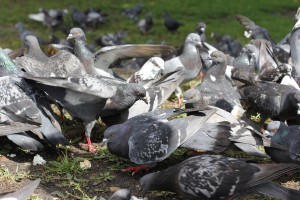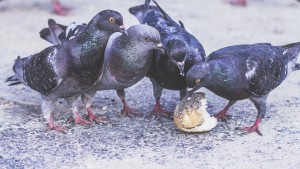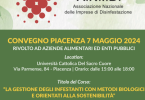In recent decades have settled in urban areas many species of wild animals. The most common are the birds: the faculty of flying allows them to more easily overcome large obstacles such as buildings, roads and other infrastructure, and find or create a shelter and habitat for their survival. The ease of finding suitable places for nesting and food of various kinds imply continuous new colonization.
The cities are preferred by birds for: warmer weather (especially in winter), the variety ‘habitat (parks, gardens, rivers, uncultivated, buildings, etc.) and greater safety (hunting and ‘prohibited and predators scarce).
Since the ’80s have multiplied even in Italy the urban ornithology searches: today you have data for over 300 nesting species observed in the city’ Italian and have been prepared in various ways ‘bird atlases nesting’ with the collaboration of various nature organizations including Italian Lipu. The data obtained  in the various areas thus allowed to further control and containment techniques especially for those species most critical points ‘in coexistence with the’ man. Among them stands out clearly Columba livia. The pigeon or Columba livia Wild West is kind of Columbide quite widespread; from his domestic form Columba livia var. Domestic, including pigeons and numerous ornamental breeds and beef, the doves descend semi-wild popular both in Italy and abroad, especially in the streets of big cities.
in the various areas thus allowed to further control and containment techniques especially for those species most critical points ‘in coexistence with the’ man. Among them stands out clearly Columba livia. The pigeon or Columba livia Wild West is kind of Columbide quite widespread; from his domestic form Columba livia var. Domestic, including pigeons and numerous ornamental breeds and beef, the doves descend semi-wild popular both in Italy and abroad, especially in the streets of big cities.
Morphological aspects
Similar in appearance to the wood pigeon (Columba palumbus), it is distinguished by:
• the lack of white spots around the neck;
• the brown beak instead of red and yellow;
• the lack of a white line that runs through the upper wing of the pigeon;
• white rump;
• the slightly smaller dimensions;
• Two horizontal black stripes on the wings; 30-35 cm long with a 62-68 cm wingspan.
The rear part under the white wings is the best identifying characteristic of the pigeon, but also the two black lines that run on the gray wings. The tail is edged in white. The head and neck are dark blue gray in adults with emerald hues. The eyes are orange and can be surrounded by gray-white rings. The legs are reddish.
Habitat
The pigeon is typical of southern Europe, North Africa, and the Middle East. In Italian cities as in many other European it is highly present, especially in the squares and parks. This often forces them to increase the frequency of maintenance operations in esterno. The pigeon is a seed-eater, so its power consists of cereals and legumes.  To indicate the category of problem animals, you typically use the term “Pest Species” defined as entities that cause an economic hardship, environmental or risk epidemiological diseases to human health. The ‘Pest Control Operator‘ PCO’s job category more committed in the field of control, containment and removal of bird species problems at various levels, but there are also companies that specialize only in this type of service. The “conflict” between man and wildlife can be real or merely perceived, economic or aesthetic, social or political in any case, is human society to determine when a species becomes “problematic” You have to remember that an animal is perceived as “problematic” when it becomes very large, or if located in areas outside its natural relevance. The problem is therefore directly linked to the density and the concentration and not to the presence of the species as such. There are areas and situations that intensify or lessen the discomfort. For example create discomfort the presence of large flocks of seagulls and / or cancellations, By the slopes of an airport with immediate easily intuibili.Ma dangers also they exist guano accumulations of pigeons which, if present in the vicinity ‘of residential areas, can create big disruption and contagion health risks for the population.
To indicate the category of problem animals, you typically use the term “Pest Species” defined as entities that cause an economic hardship, environmental or risk epidemiological diseases to human health. The ‘Pest Control Operator‘ PCO’s job category more committed in the field of control, containment and removal of bird species problems at various levels, but there are also companies that specialize only in this type of service. The “conflict” between man and wildlife can be real or merely perceived, economic or aesthetic, social or political in any case, is human society to determine when a species becomes “problematic” You have to remember that an animal is perceived as “problematic” when it becomes very large, or if located in areas outside its natural relevance. The problem is therefore directly linked to the density and the concentration and not to the presence of the species as such. There are areas and situations that intensify or lessen the discomfort. For example create discomfort the presence of large flocks of seagulls and / or cancellations, By the slopes of an airport with immediate easily intuibili.Ma dangers also they exist guano accumulations of pigeons which, if present in the vicinity ‘of residential areas, can create big disruption and contagion health risks for the population.
The level and the trend of a bird population mainly depends on the following factors: – births – dead – emigrations – immigration The natural evolution of the population sees the first phase of growth, following a logistical and a final increase of numerical stabilization because of “limiting factors” such as competition, predation, hierarchies, disease, food resources, space available, etc.). By following these simple rules in a particularly balanced environment coexist many species but neither reaches particularly high density to cause discomfort to the human population. Unfortunately some activities’ break this balance and changing the environment. This factor determines the disappearance of many species, while others, particularly adaptable and opportunistic, exploiting the new condition and rapidly increased, up to reach the threshold of “problematic species.” The areas most urbanized and rural areas with intensive agricultural activities are the most unbalanced environments, where you experience the more overcrowding of the dominant species causing inconvenience for users of ‘area. The pigeons are amongst these species which are opportunistic and can be considered to all “urban parasites” effects.
Birds and the health
Also the birds are direct or indirect holders of about 60 diseases, many of which can have even fatal outcomes. Among the more frequent you may remember:
• Ornithosis: originated from a virus (Chlamydia psittaci) that causes infections of the respiratory system. Some scholars believe the 10% of acute respiratory diseases of man is due to the birds, which transmit this infection through the dried feces and then powdered.
• Salmonellosis: (pathogen: Salmonella Sp) which is eliminated in the feces and can infect humans directly or indirectly (intake of foods previously infected by insect vectors such as flies).
• Cryptococcosis: the infection of the lungs and is spread through the circulation throughout the body. The infections of the brain and the meninges – especially in children – can be deadly.
• Histoplasmosis: looks like acute and chronic infection of the immune system that may be confused with Tuberculosis. Very often it regresses spontaneously, but fulminant cases are fatal.
 • Ascariasis: through the stool pigeon can eliminate roundworm eggs which can infect the mantle of dogs and cats. Furthermore the pigeons are carriers of ectoparasites namely: the most dangerous are the ticks (Argás reflexus). Ticks, because of their infestation, can be carriers of a Spirocheta such Borelia pathogen or even deadly to humans (Lyme disease), responsible of infections with epidemic spread. sore point and the same dangerous way is the shit (droppings) produced by pigeons. Where there is a pigeon is the pigeon’s shit! The areas affected are roofs, gutters, attics, string courses, chimneys but are not even rule out the most accessible parts such as balconies, terraces, staircases, etc. The pigeon shit unfortunately dry and shatters into small particles that can be inhaled by humans, causing serious health problems. Also the pigeon shit is a bad smell and the affected areas creates irreparable damage.
• Ascariasis: through the stool pigeon can eliminate roundworm eggs which can infect the mantle of dogs and cats. Furthermore the pigeons are carriers of ectoparasites namely: the most dangerous are the ticks (Argás reflexus). Ticks, because of their infestation, can be carriers of a Spirocheta such Borelia pathogen or even deadly to humans (Lyme disease), responsible of infections with epidemic spread. sore point and the same dangerous way is the shit (droppings) produced by pigeons. Where there is a pigeon is the pigeon’s shit! The areas affected are roofs, gutters, attics, string courses, chimneys but are not even rule out the most accessible parts such as balconies, terraces, staircases, etc. The pigeon shit unfortunately dry and shatters into small particles that can be inhaled by humans, causing serious health problems. Also the pigeon shit is a bad smell and the affected areas creates irreparable damage.
Another common and unpleasant damage affects the occlusion of the exhaust pipes (gutters) from dirt and pigeon carcasses. The strategies to removal or reduction of pigeon populations have to assess the different possible actions, their effectiveness and relative costs.
We distinguish the main intervention methodologies:
– direct
• catches with subsequent displacement
• sterilization feed
• introduction or use of natural predators
– indirect
• limitation of food sources
• limitation of nesting places and pose using bollards
From a scientific point of view the “pigeon problem” should be addressed at the local level and in ecological key with integrated interventions between them (IPM – Integrated Pest Management). Among the indirect methods, the ones that mostly involve the category of PCO and Birds Control Operators are the interventions of the bollards applications, also to be implemented at the level of individual buildings.
Main types of bollards:
– Mechanical support bollards
• Harmonic steel spikes with stailess steel, polycarbonate or copper base
• Wire type BirdWire or CableBird systems
– Electrified systems
• Modular with stainless steel threaded rods fixed on the supporting brackets of polycarbonate connected to an electronic control unit with self-regulation of the output voltages
• Modular with band electrified type Electrack or Avishock
– Intrusion networks
• polyethylene networks with knots or without knots
• in metal nets
– Visual deterrents
• balloons
• simulacrum of prey
• optical
• laser
– Fixed or portable acoustic deterrents (distress call)
• electronic control sound diffusion of highly stressful cries, synthesized and digitized emitted from speakers
There is no magic wand… Sometimes it is believed that to solve the problem of volatile enough to install any accessory considered effectiv. Unfortunately is not so! A good birds control system may be valid in a situation and ineffective or even counterproductive in a ‘other. Instead it is important to always contact specialized installers.
Mario Alessi






